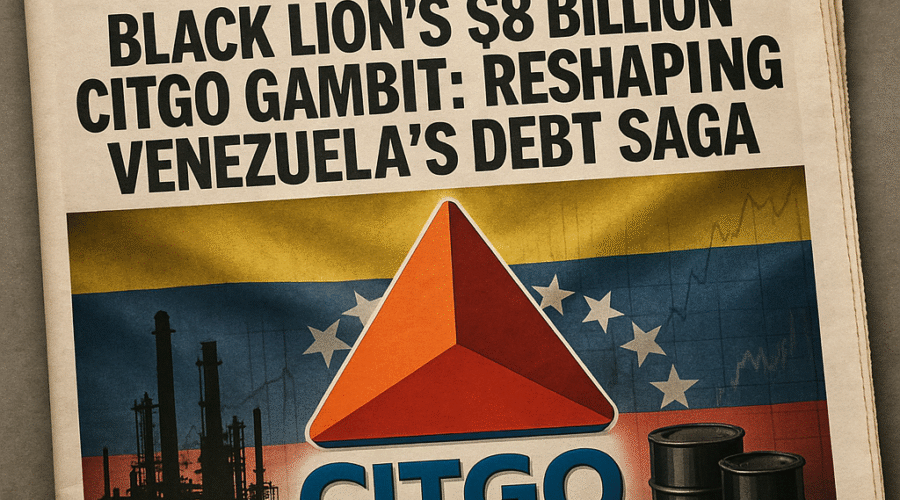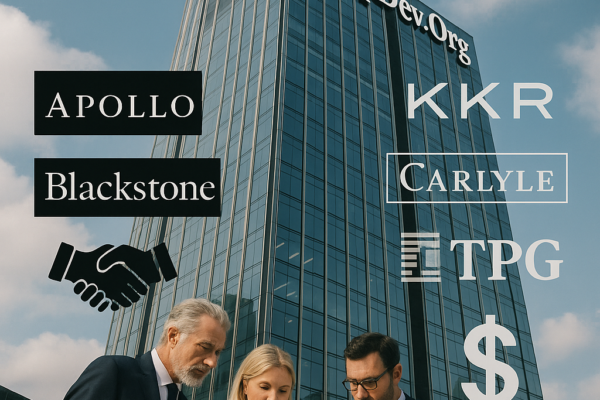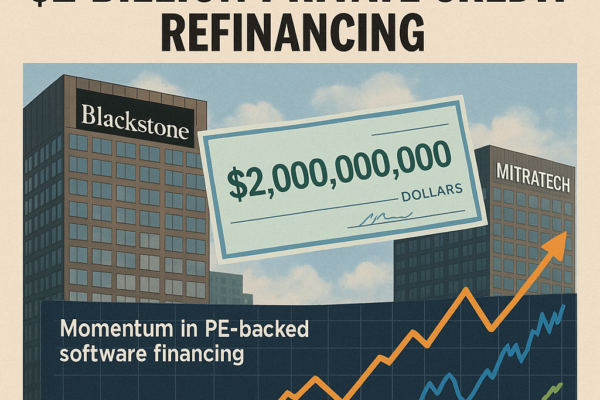The protracted legal battle over Venezuela’s crown jewel foreign asset reaches a pivotal moment as Black Lion Capital Advisors’ $8 billion all-cash bid for Citgo’s parent company emerges as the potential game-changer in a complex creditor repayment saga. This offer—the largest pure cash proposal to date—significantly outpaces the court-approved $3.7 billion stalking horse bid and positions the private equity consortium as the frontrunner in an auction process extended through August 2025. The bid’s structure, featuring institutional backing from Quazar Investment, Anex Management, and Fortress Management alongside commitments covering up to $3 billion in ancillary costs, represents a strategic bet on Citgo’s refining network value while navigating labyrinthine creditor hierarchies and U.S. Treasury sanctions[9][10][12].
💼 Seasoned CorpDev / M&A / PE expertise
Origins of the Citgo Auction: Legal Precedents and Creditor Hierarchy
Venezuela’s Default Legacy and Attachment Orders
The auction stems from Venezuela’s sovereign debt defaults and asset expropriations dating to the Hugo Chávez era, culminating in 18 validated creditor claims totaling $21.3 billion. U.S. District Judge Leonard Stark’s 2018 attachment order on PDV Holding shares—Citgo’s parent—established the legal mechanism for compensation, with creditors prioritized on a “first come, first served” basis through a structured waterfall distribution[2][3][7]. Crystallex International’s $1.2 billion arbitration award for gold mining expropriation initiated the process, followed by claims from ConocoPhillips ($1.3 billion), O-I Glass ($700 million), and Tidewater ($80 million), creating a complex mosaic of senior and junior creditors[2][13]. The Delaware court’s jurisdiction over PDV Holding, a U.S. subsidiary of Venezuela’s state oil company PDVSA, provided the necessary legal leverage despite Venezuela’s objections to what President Nicolás Maduro termed “robbery” of national assets[4][14].
Failed Auction Cycles and Process Evolution
Initial auction attempts collapsed in 2024 when creditors rejected Elliott Investment Management affiliate Amber Energy’s $7.3 billion conditional offer, citing undervaluation and problematic terms[1][2][18]. This failure prompted Special Master Robert Pincus to redesign the process around a stalking horse bid mechanism, establishing a price floor to anchor subsequent offers. Contrarian Funds’ Red Tree Investment secured this role in March 2025 with a $3.7 billion bid, though its valuation represented barely 17% of total claims—highlighting the gap between creditor expectations and market realities[1][18][15]. The court’s subsequent extension of bidding deadlines to June 2025 reflected deliberate efforts to cultivate competitive tension, with Judge Stark explicitly prioritizing bid value over transactional certainty despite parallel litigation risks[3][11][15].
Bidding Dynamics: Strategic Positioning and Offer Structures
Black Lion’s Entry and Bid Architecture
Black Lion Citgo Group’s late-stage $8 billion all-cash proposal disrupted the auction landscape through its unprecedented liquidity provisions and consortium backing. Unlike earlier bidders who participated in preliminary rounds, Black Lion leveraged extended due diligence periods to structure an offer featuring $8 billion base consideration plus up to $3 billion earmarked for court-mandated costs, insulation funds, and government fees—effectively creating an $11 billion enterprise commitment[9][10][12]. The absence of claims-based financing distinguishes it from competitor proposals, eliminating valuation disputes over Venezuelan debt instruments and reducing execution complexity. Institutional partners Quazar Investment and Fortress Management bring specialized distressed-asset expertise, while Anex Management’s energy sector experience signals operational readiness—a critical factor given Citgo’s 807,000-barrel-per-day refining footprint[10][13].
Competitive Bid Landscape
Gold Reserve’s creditor consortium—including Koch Industries subsidiaries and Rusoro Mining—previously held the lead with a $9 billion hybrid offer combining cash and attached claims, though its junior creditor status creates recovery uncertainty[6][13]. Similarly, Carl Icahn-backed CVR Energy’s $8 billion cash bid lacked Black Lion’s ancillary funding commitments, while Amber Energy’s revived participation remains shrouded in confidentiality[13][18]. The strategic divergence emerges most sharply in financing structures: Gold Reserve’s reliance on debt financing through three institutions contrasts with Black Lion’s fully committed capital, introducing variable execution risk profiles[6][10]. Judge Stark’s directive to prioritize bid value over closing certainty further advantages Black Lion’s cleaner structure, as competing offers must price in litigation exposure from Gramercy Funds’ parallel claims and PDVSA 2020 bondholder disputes[3][15].
Creditor Strategies: Alignment and Conflict
Senior-Junior Creditor Tensions
The court-defined creditor waterfall intensifies strategic fragmentation, with senior claimants like Crystallex and ConocoPhillips prioritizing liquidity while junior creditors pursue equity participation. Gold Reserve’s bid exemplifies this divide, offering warrant-based participation to junior creditors in exchange for claim contributions—a structure potentially delivering 30-40% recovery on its $1 billion claim versus minimal waterfall distribution[4][6]. Conversely, Black Lion’s all-cash approach universally benefits senior creditors but provides junior claimants limited recovery beyond the waterfall’s residual proceeds[10][15]. This dynamic fuels creditor factionalism, evidenced by March 2025 objections to Red Tree’s stalking horse designation from mid-tier claimants demanding higher minimum bids[1][18]. The absence of a unified creditor front complicates bid evaluation, forcing Special Master Pincus to balance competing recovery expectations against total offer value[15][18].
Political and Diplomatic Dimensions
Venezuela’s opposition-appointed Citgo supervisory boards retain operational control under U.S. Treasury protection through March 2025, creating a tripartite power struggle between creditors, the Maduro government, and U.S. regulators[8][14]. Treasury’s OFAC License 5J explicitly prohibits share transfers without authorization, embedding a political veto into the auction’s final stage[14]. Maduro’s administration has consistently denounced the process as illegal asset seizure, while simultaneously negotiating sanctions relief through electoral concessions—a diplomatic tightrope affecting Treasury’s ultimate approval calculus[4][8]. Creditor strategies increasingly reflect this geopolitical reality, with Black Lion’s $3 billion insulation fund potentially earmarked for settlement facilitation and Gold Reserve’s consortium including entities with existing Venezuela exposure[6][10][14].
Regulatory and Execution Hurdles
OFAC Approval Framework
The U.S. Treasury’s Office of Foreign Assets Control maintains decisive authority through its Venezuela sanctions program, requiring explicit authorization for ownership transfer under General License 5J[8][14]. Historical precedent suggests conditional approvals favoring bids that preserve refinery operations and U.S. energy security, with Treasury’s March 2025 license extension signaling cautious engagement[8][12]. Black Lion’s bid faces particular scrutiny given private equity ownership models versus strategic operators like Koch or CVR Energy, though its $3 billion insulation fund may alleviate concerns about post-acquisition stability[10][13]. Parallel litigation from Gramercy Funds and PDVSA 2020 bondholders—claiming structural seniority through New York judgments—creates additional clearance complexity, potentially requiring escrow arrangements that diminish net creditor recoveries[3][15].
Timeline and Process Risks
Judge Stark’s June 2025 calendar extension to August 18 final hearing reflects mounting procedural complexity, with Special Master Pincus now tasked with evaluating bids against multidimensional criteria by July 2[11][12]. The timeline compression introduces material execution risk: Treasury review typically requires 60-90 days, potentially pushing final approval into late 2025—beyond current OFAC protection expirations[8][12]. Black Lion’s bid specifically references “customary due diligence” contingencies, leaving room for renegotiation if asset inspections
Sources
https://www.oilandgas360.com/new-creditors-battle-emerges-in-citgo-auction-reboot/, https://venezuelanalysis.com/news/venezuela-citgo-auction-judge-orders-bidding-restart-greenlights-parallel-lawsuits/, https://usaherald.com/citgo-auction-deadline-extended-in-venezuela-debt-battle/, https://energiesnet.com/gold-reserve-leads-citgo-auction-with-strategic-bid/, https://aiimafrica.com/media/3449/fm_mainbody_26052022.pdf, https://www.ainvest.com/news/gold-reserve-citgo-bid-high-stakes-gamble-creditor-priorities-regulatory-clearance-2506/, https://courts.delaware.gov/Opinions/Download.aspx?id=355990, https://www.marinelink.com/news/us-extends-protections-citgo-march-518980, https://www.tradingview.com/news/reuters.com,2025:newsml_L1N3SS0JJ:0-black-lion-submits-8-billion-cash-bid-for-citgo-s-parent-filing-says/, https://www.venezuelapolitica.info/wp-content/uploads/2025/06/Black-Lion-presenta-una-oferta-por-CITGO.pdf, https://www.tradingview.com/news/reuters.com,2025:newsml_L1N3SE0KC:0-us-judge-extends-citgo-auction-s-calendar-final-hearing-moved-to-aug/, https://www.ainvest.com/news/citgo-auction-delayed-august-18-fair-process-2506/, https://energynow.com/2024/08/citgo-auction-pits-icahn-backed-oil-refiner-creditor-group/, https://misionverdad.com/english/possible-scenarios-citgo-ofac-5j-license, https://octus.com/resources/articles/court-opinion-review-050825/, https://energy-analytics-institute.org/wp-content/uploads/2025/03/4Q24-NRGProspector_EnergyAnalyticsInstitute_lowres.pdf, https://www.fidelity.com/news/article/mergers-and-acquisitions/202504211904RTRSNEWSCOMBINED_L1N3QZ0UV_1, https://kfgo.com/2025/03/21/contrarian-funds-3-7-billion-offer-recommended-as-starting-bid-in-citgo-parent-auction/, https://bigpicture.site.seattleartmuseum.org/works/how-my-mothers-embroidered-apron-unfolds-in-my-life/how-my-mothers-embroidered-apron-unfolds-upon-my-life/





